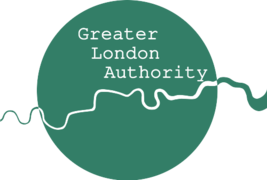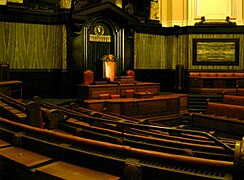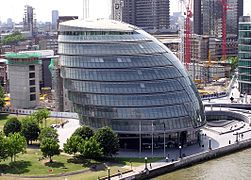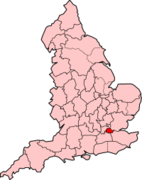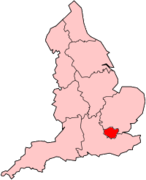History of local government in London
Appearance
Thehistory of local government inLondon,England, spans a number of periods.
| From | Legislation | System |
|---|---|---|
| 1835 | Municipal Corporations Act 1835 | The small, ancient and self-governingCity of Londonis unreformed by legislation covering the other major city corporations and does not expand into the growing metropolitan area surrounding it. The area that is currentlyGreater Londonis administered byparishesandhundredsin the counties ofMiddlesex,Essex,Kent,SurreyandHertfordshire,with very little co-ordination between them.[1]Special areas such as theLiberty of Westminsterare exempt from county administration. In other areasad-hocsingle-purpose boards are set up. Commentators consider it to be a system 'in chaos'.[1] |
| 1855 | Metropolis Management Act 1855 | TheMetropolitan Board of Worksis created to provide the infrastructure needed in the area now known asInner London,its members are nominated by the vestries and boards.[2] |
| 1889 | Local Government Act 1888 | TheCounty of Londonis created from the area of responsibility of the Metropolitan Board of Works.[3]ALondon County Councilshares power with the boards and vestries. The City of London is outside of its scope.CroydonandWest Ham(and laterEast Ham) becomecounty boroughsoutside the County of London but also outside the control of the newly formed Surrey and Essex county councils. |
| 1894 | Local Government Act 1894 | The rest ofEngland,including the area around the County of London and the county boroughs (but not within it), is divided intourban districtsandrural districts.In the Greater London area they become consolidated over the next 70 years intomunicipal boroughsand urban districts with no rural districts remaining. Many districts later become populous enough to apply for county boroughs status, but are rejected. ARoyal Commission on the Amalgamation of the City and County of Londonattempts to facilitate the merger of the City and County of London, but fails. |
| 1900 | London Government Act 1899 | Metropolitan boroughsare created within the County of London and functions are shared with the London County Council. The vestries, boards and liberties in the area are abolished. |
| 1965 | London Government Act 1963 | An enlargedGreater Londonreplaces the County of London,Middlesex County Council,the county boroughs and all local government districts within around a 12-mile radius. The mostly strategicGreater London Councilshares power with the 32London boroughsand the City of London.[4] |
| 1986 | Local Government Act 1985 | The Greater London Council is abolished and the London boroughs work as unitary authorities with strategic functions organised by joint boards and quangos.[5]A residualInner London Education Authorityremains for the inner area, but is abolished during a national reform of education. |
| 2000 | Greater London Authority Act 1999 | The regionalGreater London Authority,consisting of theMayor of Londonand theLondon Assemblyassume a strategic function, sharing power with the London boroughs and the City of London.[6] |
Gallery[edit]
-
Logo of theMetropolitan Board of Works
-
Flag of the London County Council (1914-1965)
-
Coat of arms ofGreater London Council
-
Banner of theGreater London Council(1965-1986)
-
Greater London Authoritylogo (2000-2001)
-
Greater London Authority logo (2001–present)
-
Spring Gardens, home of theMetropolitan Board of Works
-
County Hall,former home of the London County Council and Greater London Council
-
Council chamber within County Hall
-
City Hall, London (Southwark),home of the Greater London Authority from 2002 to 2021
-
City Hall, London (Newham),home of the Greater London Authority from January 2022
-
City of London (red) compared to Greater London
-
County of London shown within England (in 1889)
-
Greater London shown within England
-
County of Londoncompared to Greater London
-
A map of the wards of the City as they were in the late 19th century.
See also[edit]
References[edit]
- ^abBarlow, I.,Metropolitan Government,(1991)
- ^Saint, A.,Politics and the people of London: the London County Council (1889-1965),(1989)
- ^Thomson, D.,England in the Nineteenth Century (1815-1914),(1978)
- ^Redcliffe-Maud & Wood, B.,English Local Government Reformed,(1974)
- ^Kingdom, J.,Local Government and Politics in Britain,(1991)
- ^Jones, B. et al.,Politics UK,(2004)
Bibliography[edit]
- Barlow, IM (1991).Metropolitan Government.Routledge.ISBN0415020999.
- Kingdom, John E (1991).Local Government and Politics in Britain.Philip Allan - Contemporary Political Studies.ISBN0860038319.
- Redcliffe-Maud, John;Wood, Bruce (1974).The Pelican History of England.Vol. 8.Oxford University Press.ISBN019888091X.
- Saint, Andrew,ed. (1989).Politics and the people of London: the London County Council, 1889–1965.Hambledon P.ISBN1852850299.
- Thompson, David(1973).England in the Nineteenth Century (1815-1914).Penguin Books.ISBN0140201971.
Vol. 8 ofThe Pelican History of England
Further reading[edit]
- Torrens, William McCullagh(1884)..London: Kegan Paul, Trench, and Co.






